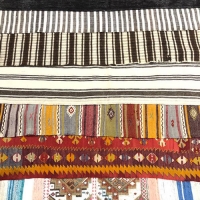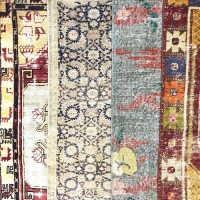
The first carpet samples in the world
After 711 BC, in the context of the art of weaving, carpet and rug studies have been spread in Western Europe. Carpets 15th century -17. It was associated with the art of various societies between the centuries. The carpet art in some places has experienced the most brilliant periods. From the 19th century onwards, the carpets began to leave from the essence of the carpets due to the interventions of the pleasures and desires of the people.
However, in some regions, carpet weaving has come to our time as a folk art. After a certain period of time, weavers and carpet masters who went to Italy and Southern France started to be produced in South France with the technique of knot by the name "Aubuson" and "Savonnerie". In 1539, the first carpet was woven on a vertical hand loom in Europe. In 1604, Pierre du Pont realized the weaving of the first horizontal semi-automatic carpet loom in Paris. In 1655, a carpet factory was established in Wilton, southern England. These carpets are also called Wilton carpets. The two weavers Jemaula and Dufossy taught the weaving of Wilton and taught the weaving of carpets on the horizontal workbench with Brussels-type footswitches.
Brussels carpet loom was built in 1749. Dufossy produced the first cut pile carpet by placing a knife on the end of the crochet which provides the pile formation of Brussels carpets. Then these carpets are named as Wilton type. In 1801, in France, Josep Maria Jacuard developed jacquard looms and produced five colored carpets. In Scotland in 1830, James Templeton and William Quinley had a bir Chenille Axminster leton carpet in two stages. In 1831, Richard Whytock developed the tapestry carpet weaving by pressing the pile yarns. The mechanical rug loom was developed by the work of Collier and Crossley, known as the non-hand-driven power loom. Around 1854 Tapestry tapestries were woven. However, as a full power loom, the carpet bench was used for the first time by the American E. P. Bigelow in Brussels between 1840 and 1845. The next technique was a great advance in 1876 by New York's Alexander Smith and H. Sikinner invented the y Moket or Royal Axminster bench. Carpets woven in Axminster are named as ster Axminster carpet “. Thus, the carpet patterns can be obtained by wrapping a large number of color rollers respectively. This roller system is called ”Spool Axminster. In 1878, the min Spool Axminster bench was moved from the United States to England by Tomkinson and Adam Kidderminster. In 1890, Kidderminster developed the ası Gripper Axminster tez bench by applying jacquard mechanism to the countertop. Later ”Spool Axminster“ and “Gripper Axminster” systems were combined and “Spool-Gripper Axminster“ system was created. With the discovery of electrical energy in 1930, the individual was driven from the mass drive in the steam system and the movement of the machine.



